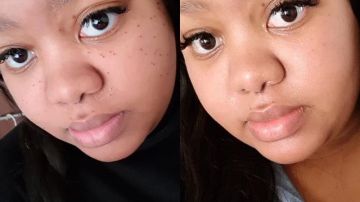What Are These Little Black Moles on My Face?
As a little girl, I used to find countless ways to annoy my mom

Photo: Instagram/dermologysandton
As a little girl, I used to find countless ways to annoy my mom. One of them involved counting the “bumpy freckles” on her face. She had a small clustering of them under her eye, which I found not only “cool” but also intriguing. I wondered if it was a sign of womanhood, another one of the things I couldn’t wait to have when I grew up — “grown-up freckles.” At the time, mine were flat and I only had three that I could count. But these were like little chocolate candies floating in small clusters creating a gorgeous three-dimensional depth to her beauty. What were they?
I only recently discovered that they were hereditary — I’ve since developed a few of my own in adulthood — and they are actually part of a condition called dermatosis papulosa nigra or DPN (Morgan Freeman has it), a benign condition of the skin that typically affects people of color and 35% of Black people. As common as it is, I decided to do a deeper dive into what it is and how it can and should be treated (or honored, as I like to say considering I’ve always found it to be a rather dope trait to have).
wp_*posts
What is DPN?
According to Dr. Shari Hicks–Graham, MD, FAAD, an African American dermatologist practicing medical and cosmetic dermatology in Columbus, Ohio, claims DPN (also called “flesh moles”) is a completely harmless condition.
“The lesions begin as very small, 1-3 millimeter growths on the surface of the skin and are a dark brown color. At first, they may appear to be flat, but then over time, they enlarge slowly and become raised, or may coalesce into larger groups of papules. They are not painful, nor do they cause harm.”
As I predicted, they are hereditary and occur in various people of color.
“DPN is more common in people of color (Asians, Latinos, and Blacks),” explained Dr. Rosemarie Ingleton, a Dove dermatologist and founder of New York City’s Ingleton Dermatology.
wp_*posts
Is DPN Treatable?
While it’s not necessarily something that needs to be “treated,” because it is not a harmful skin condition nor is it related to skin care, some people do choose to have the lesions removed for aesthetic purposes.
According to Dr. Hicks-Graham, the best way to remove them is via electrodesiccation or “electrocautery.”
“During this simple procedure, a dermatologist utilizes what appears to be a small electric pen to remove the moles one by one. A topical anesthetic may be applied 1-2 hours prior to the cosmetic procedure, and discomfort is limited.”
One can also try a more expensive option: laser treatments.
“After the procedure, the lesions become smaller, and look grey in color,” Dr. Hicks-Graham explained. “Over the following 1-2 weeks, the lesions fall off leaving a clearer complexion.”
Those who choose to do either procedure should be aware that sometimes the lesions will come back and the treatment will have to be repeated. wp_*posts
What Skincare Process Should People with DPN Follow?
Generally, if you have DPN you can adhere to a standard skincare process: use a gentle cleanser and moisturizer with sunscreen.
However, if you choose to have them removed via laser treatment, Dr. Ingleton suggests you work with your dermatologist to develop an appropriate skin care regimen afterward.
“The best skin-care approach is to visit a dermatologist who is comfortable and properly trained to treat skin of color for a consultation to discuss what’s best for your skin,” Dr. Ingleton shared.
wp_*posts
What Things Should You Avoid When You Have DPN?
“Don’t wait to seek treatment until they become large and too numerous to count,” Dr. Hicks-Graham warns. “If you aren’t a fan of the lesions when they are small, chances are you will like them even less when they get larger. Sizable DPN’s are more challenging to remove and often require multiple treatments.”
For those who don’t choose to seek treatment, it’s important to not get handsy with the lesions.
“Do not pick at them!” Dr. Ingleton encourages. “Do not cut or clip them off on your own. See a board-certified dermatologist and have them properly removed to avoid scarring and dark spots.”
wp_*posts
How Can You Feel Confident In Your Own Skin, Even With DPN?
Despite having this skin condition, how you rock it is all about perspective. Millions of brilliantly beautiful women proudly rock freckles, birthmarks, and DPN, including Beyoncé and other unique identifiers. With the right skincare routine, you can feel confident in the skin you were born with.
wp_*posts
What’s the Best Skin Routine for Darker Skinned Women?
While it’s easy to feel confident in your dark skin tone, it’s also important to maintain a routine that gives you optimal “glow.”
“Those with darker skin tend to show the appearance of the tight/dry feeling or ‘ashiness’ on the skin, whereas a lighter tone person may not have the same appearance,” Dr. Ingleton reminds us. “This is one of the many reasons I always recommend my patients use a truly hydrating and mild cleanser like the Dove Beauty Bar. It not only cleanses the skin, but replenishes the moisture lost in the shower with its key ¼ moisturizing cream, leaving skin soft, smooth, and glowing.”

















